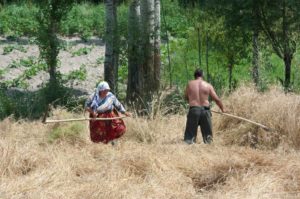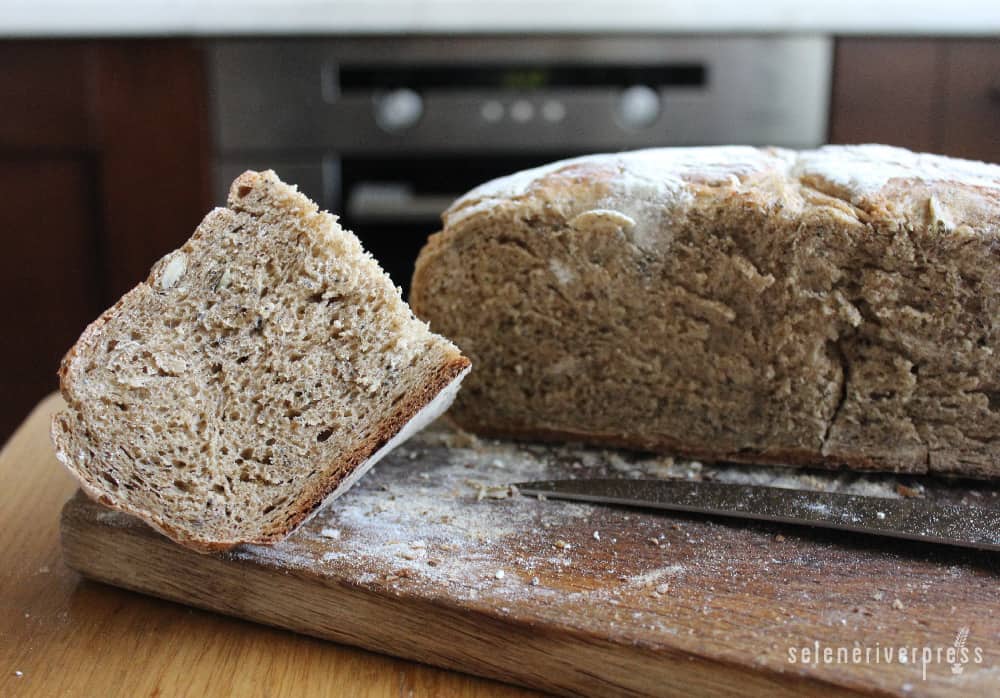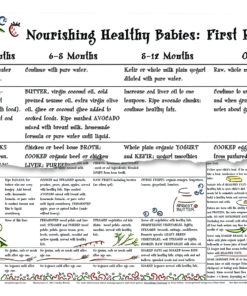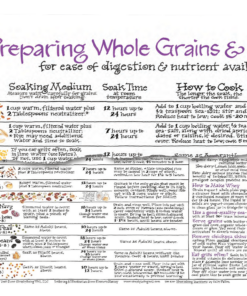Last I checked, more than three million Americans have celiac disease, and about eighteen million (6 percent of the population) experience gluten sensitivity or gluten intolerance (also known as non-celiac gluten sensitivity, or NCGS).
Gluten is an elastic protein responsible for the elastic texture of dough. When it comes to the rapid rise of gluten intolerance, part of the problem may lie in the type of wheat we typically use for baked goods. And part of the problem may lie with the quality of the wheat we use (in particular, whether it is conventionally or organically grown).
However, I suggest two culprits that share a larger part of the blame: the way we harvest our wheat, and the way we have produced bread and baked goods for the last century and counting. This method of baking has not and will not serve our health, gluten free or not. Thankfully, the remedy is really quite simple.
Many researchers have traced our gluten problems to the hybridization of wheat that began in the early 1950s. As I touch on above, I would like to consider two other events of the late 1800s and early 1900s that are even more responsible. These were seen as “advancements” at the time, but they have since had a negative effect on our health—and our digestion. I am talking about the mechanization of agriculture and the rise of modern baking (pun intended).
We will talk about this more thoroughly, travelling back in time to the “amber waves of grain” of the American heartland at the turn of the last century. But first I want to examine about what wheat is at its core—a seed—and why that is a problem.
Wheat Berries (and All Grains) Are Seeds
Wheat berries are that part of the plant that we harvest and grind into flour. No matter the variety, they are seeds, just like other grains. Seeds want to turn into plants, and they will do so given the correct conditions: light and water. Seeds also want to reproduce, which means they do not want to be digested by you or any other animal that might eat them.
Now, back to that wheat field…
The Mechanization of Agriculture: Do Harvesting Methods Wreak Havoc?
Here we are in the United States of the late 1800s and early 1900s. It is harves ting time. No tractors or combines to be seen. Just men, women, and children with scythes and sickles, cutting down wheat by hand. This is hard work. It takes time—days at least. Depending upon the size of the crop and the number of people harvesting, it can even take weeks. Then, once harvested, it might be several days or more before the wheat is taken to the mill to grind into flour. The harvested wheat may be stored outdoors, exposed to sunlight and water (in the form of rain or dew). Left on the ground, the grain soaks in moisture. Under these conditions, wheat berries do what seeds are meant to do: sprout into plants. By the time the wheat arrives at the mill, the wheat berries have likely sprouted. It is therefore sprouted flour.
ting time. No tractors or combines to be seen. Just men, women, and children with scythes and sickles, cutting down wheat by hand. This is hard work. It takes time—days at least. Depending upon the size of the crop and the number of people harvesting, it can even take weeks. Then, once harvested, it might be several days or more before the wheat is taken to the mill to grind into flour. The harvested wheat may be stored outdoors, exposed to sunlight and water (in the form of rain or dew). Left on the ground, the grain soaks in moisture. Under these conditions, wheat berries do what seeds are meant to do: sprout into plants. By the time the wheat arrives at the mill, the wheat berries have likely sprouted. It is therefore sprouted flour.
What does that mean for the digestibility of the flour? A lot! Flour from sprouted seeds (sprouted flour) is much easier to digest than unsprouted flour. In the early days of baking, all flour was sprouted because it was all made from plants! It was not made from ground-up seeds as it is today—and has been for the last hundred years or so.
The human digestive system can break down plants far more easily than it can digest seeds. (Well, almost. Seeds have natural “anti-nutrients” that protect them from being digested and prevent us from accessing their nutrients. However, you can easily unlock those nutrients using traditional cooking methods. My “Preparing Whole Grains and Legumes” chart can show you how.)
Our grandmothers and great-grandmothers baked with sprouted flour, which is easier to digest than modern wheat flours. The first input—the ingredients—were easier on the digestive system. In fact, eating bread and baked goods from sprouted flour may not have posed any digestive difficulty at all, by virtue of the fact that it was made from seeds that had been allowed to sprout (in other words, plants). And, of course, by virtue of the way our grammies baked.
The Rise of Modern Baking and the Demise of Sourdough
Over the years, using sprouted flour in baking may have been all it took to help ease digestion, at least in part because it can be entirely gluten free. (According to the Gluten Intolerance Group, a national celiac disease support organization, gluten is not present once the wheat sprouts into a plant.)
But there was something else at play. Our ancestors were almost guaranteed ease of digestion simply because of the way they baked! Traditional methods of preparing sourdough bread and other baked goods predigests the proteins in the flour. By breaking down that gluten and preserving the bread longer than yeast-risen bread, the fermentation process does all of the work for us.
Unfortunately, by the mid-1800s sourdough began to go by the wayside. The modern age of baking began when we removed the precious germ and bran, and then added chemicals to the process. Once we invented baking soda and baking powder, “quick breads” became the norm. Quick breads are just that: quick. The dough does not require a long fermentation or the need to make and maintain a starter as sourdough breads do. Bakers and homemakers could now achieve in minutes what previously took days. But the gain in time resulted in the loss of nutritional value—and the taxing of our digestive systems!
Almost All of the Baked Goods in the Store Are Not digestible!
What does all of this mean? It means that we can no longer digest the vast majority of breads, rolls, buns, crackers, cookies, cakes, bagels, and all other baked goods from the grocery store—organic or not. Period. And it’s been this way for a hundred years, both in home kitchens and since the advent of the grocery store. This has a tremendous effect on our GI system and digestive health. Rather than “the staff of life,” bread is now the “kiss of death.” Bite by bite, we slowly injure our small intestines and become more malnourished. Our inability to digest baked goods causes a whole host of symptoms that extend beyond the digestive system: depression, anxiety, iron-deficiency anemia, fatigue, arthritis, osteoporosis, liver disorders, joint pain, neuropathy (tingling, numbness, or pain in the hands and feet), infertility, migraines. The list goes on.
What Is the Remedy?
Still want to eat bread and baked goods? Or do you want to eat healthful bread and serve it to your family? Look at the following options available to you, starting with the good and ending with the best.
- Purchase only baked goods made from sprouted flour. Be sure the label does not list “vital wheat gluten,” which you do not want!
- Purchase sourdough and baked goods from a real baker or bakery. Ask the baker if the sourdough is traditionally made: no added yeast, no added vital wheat gluten, and a long fermentation time (over 12 hours or up to 36 hours).
- Purchase sprouted flour for your own baking.
- Better yet, make your own sourdough. The easiest recipe I have found is from The Nourishing Traditions Cookbook for Children by Sally Fallon Morell.
- Best? Grind your own flour and make your own sourdough. Learn more about the benefits of grinding your own flour and buy the best flour mill available!
Wishing you well on your journey to finding the best nutrient dense bread for you!
Further Reading
If you’re interested in learning more about the problems with white flour, you will find a deep source of research and information at the SRP Historical Archives.
More on the mechanization of agriculture:
- “Agricultural Mechanization History, Part 1”
- “AgBioForum: Mechanized Agriculture: Machine Adoption, Farm Size, and Labor Displacement”
More on baking soda and baking powder:
Photos from iStock/BoStarch (main image), ollirg (harvesting wheat), Halfpoint (woman’s hands)






I have to disagree with this article. Please read below to understand why I would never tell someone with Celiac Disease that it might be OK to eat wheat under certain conditions. It is very dangerous advice for people who have gotten a diagnosis of Celiac or NCGS, because many of these folks are so desperate to replace their gluten-laced favorites that they will try anything until they find themselves very sick.
For me, it took several years to come to terms with what Celiac Disease means and for the first few years after my diagnosis, I tried to convince myself that I could find a way to avoid changing my lifestyle and eating habits. I’m from the “been there done that” crowd and can tell you from experience that sprouting and fermenting does not work for those with true Gluten Sensitivity.
When I was first diagnosed with Celiac Disease, I read a book that put forth this theory (I was actually working from Sally Fallon’s book, NOURISHING TRADITIONS) – which stated that if you use sprouted grain and if you ferment the dough, then the gluten is “denatured” and thus safe to eat. I proceeded sprout my grains and I obtained a sourdough starter – continuing to bake bread with wheat, rye, barley, spelt, etc. I spent a lot of time and money learning to be a very good sourdough baker. But, I learned a very hard lesson from this. For me, this was a pretty dangerous path to go down as I tried it with the result of being severely ill with months and months of recovery. It didn’t happen overnight, but when I started reacting to the new baking regimen, It was worse that it had been before, with symptoms of MS cropping up. This in addition to the issue of cross contamination are two things that were a stumbling block for me on my health journey. Ultimately, I had to face that fact that gluten is bad for me and nothing was going to change that.
Sprouted Sourdough bread might be the best way to bake wheat flour, but it is still full of gluten. And even though it makes for a healthier bread overall for “normal” people who don’t have Celiac Disease or NCGS, it is still very dangerous for folks who have true gluten sensitivity. If I had known some of the facts stated in this article decades ago (or better yet, if my parents had know this), I might have prevented the onset of Celiac. But once it was triggered, I am convinced that nothing was going to turn it back.
This myth has been going around for awhile and scores of people are staying sick because they mistakenly believe that such things as “organic”, “Non-GMO”, “sprouted”, and “sourdough” will make things OK when it really isn’t NOT OK for true Gluten Sensitive people. Some of us simply can never, ever eat gluten grains, or even touch them. For me, one molecule on the skin can send my system into a tizzy, and repeated exposures over a long period of time can make me bedridden for months.
Celiac can be a very minor inconvenience or it can be a serious health risk, depending on whether the patient is compliant to a 100% gluten-free lifestyle. That means not contact with gluten grains, ever. Over the years, I have realized that bread is just not worth it and once I accepted that fact, I find that it ins’t really all that important to me to have it.
Anyway I really appreciate your perspective and your information about the problems with the way wheat is bred, grown, harvested and baked. This is all good information and I agree with most of it. But, when it comes to gluten grains and Celiac, I have to put my 2 cents worth into the pot! It is simply not true that there is no gluten in sprouted wheat because each grain sprouts at an individual rate and there is way too much opportunity for cross contamination or unsprouted seeds in the batch. Until all seeds have been sprouted and the whole batch is fully WHEAT GRASS with no grain left, it still has some gluten present. And when it is fully GRASS, you cannot make it into bread.
I consider this article to be good advice for the general population but terrible advice for Celiacs and NCGS patients. Both sides need to be told before anyone jumps on this bandwagon! Following this regimen was responsible for ruining a whole year of my life. This is NOT for Celiacs.
Hi Linda,
Maria Atwood asked me to reply this to you:
I too am a Selene River Press blogger; however I don’t use Face Book or other social media (too busy)! And have asked an admin to kindly post my response to your comments on Monica’s blog post.
In an article (To Gluten or Not To Gluten) that I wrote and which was published by the Weston A. Price Foundation https://www.seleneriverpress.com/to-gluten-or-not-to-gluten/ I outlined many related situations concerning gluten. One of the major findings that blew me away is the fact that when we stop eating or cannot eat a certain food, in this case gluten containing grains we actually lose the enzyme that helps digest that food!
I also address those who are like you and are truly diagnosed as Celiac and recommend no gluten containing grains, and or other hundreds of gluten containing substances. However according to many studies done by Royal Lee, founder of Standard Process Whole Food Supplements and one recommendation made by Dr. Cowan whose on the board of the Weston A. Price Foundation and who recommends Okra Pepsin E3 https://www.standardprocess.com/Products/Standard-Process/Okra-Pepsin-E3#.WmNnQnlG0oA along with a very carefully monitored diet recommended by Sally Fallon Morrell which I also include in the article, have in fact resolved many and in some case all of the issues that suffers of this unfortunate and cumbersome disorder have to put up with. I am of course not a doctor and the final decision maker on whether or not your one of those who may benefit from the articles suggestion is up to you.
I would therefore invite you to read the article and maybe like one lady from New York called me about six months after having read the article and taken it to heart, was virtually crying over the phone and told me that after numerous years she was now eating one slice of Einkorn sourdough bread daily (very low gluten) while taking her Okra Pepsin E3 daily, and would be trying making a Sourdough Spelt version in a few weeks. It was truly music to my ears as apparently her digestive system had started to produce that special enzyme that helps digest gluten, and the Okra Pepsin E3 had been efficacious in helping the gut to heal. Dr. Cowan could explain how this unique supplements works.
Maria Atwood, CNHP